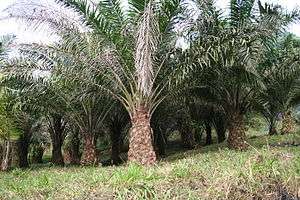Palm kernel oil
Palm kernel oil is an edible plant oil derived from the kernel of the oil palm Elaeis guineensis.[1] It should not be confused with the other two edible oils derived from palm fruits: palm oil, extracted from the pulp of the oil palm fruit, and coconut oil, extracted from the kernel of the coconut.[2]
Palm kernel oil, palm oil, and coconut oil are three of the few highly saturated vegetable fats; these oils give the name to the 16-carbon saturated fatty acid palmitic acid that they contain.
Palm kernel oil, which is semi-solid at room temperature, is more saturated than palm oil and comparable to coconut oil.
History

Oil from the African oil palm Elaeis guineensis has long been recognized in West African countries. European merchants trading with West Africa occasionally purchased palm oil for use in Europe, but palm kernel oil remained rare outside West Africa.[3]
The USDA has published historical production figures for palm kernel oil for years beginning October 1 and ending September 30:[4]
| Year | Production, Million Tonne |
|---|---|
| 2008–09 | 11.75 |
| 2009–10 | 12.22 |
| 2010–11 | 12.55 |
| 2011–12 | 13.28 |
Research institutions
In the 1960s, research and development (R&D) in oil palm breeding began to expand after Malaysia's Department of Agriculture established an exchange program with West African economies and four private plantations formed the Oil Palm Genetics Laboratory.[5] The Malaysian government also established Kolej Serdang, which became the Universiti Pertanian Malaysia (UPM) in the 1970s to train agricultural and agroindustrial engineers and agribusiness graduates to conduct research in the field.
In 1979 with support from the Malaysian Agricultural Research and Development Institute (MARDI) and UPM, the government set up the Palm Oil Research Institute of Malaysia (Porim),[6] a public-and-private-coordinated institution. B.C. Sekhar was appointed founder and chairman. Porim's scientists work in oil palm tree breeding, palm oil nutrition and potential oleochemical use. Porim was renamed Malaysian Palm Oil Board in 2000.
Nutrition
Palm kernel oil, similarly to coconut oil, is high in saturated fats and is more saturated than palm oil.[7] Palm kernel oil is high in lauric acid which has been shown to raise blood cholesterol levels, both as LDL-C (cholesterol contained in low-density lipoprotein) and HDL-C (cholesterol contained in high-density lipoprotein).[8] However, the raise in total cholesterol concentration is partly due to more HDL-C than LDL-C.[9] Palm kernel oil does not contain cholesterol or trans fatty acids.[10]
Palm kernel oil is commonly used in commercial cooking because it is lower in cost than other oils and remains stable at high cooking temperatures. The oil can also be stored longer than other vegetable oils.[10][11]
The approximate concentration of fatty acids (FAs) in palm kernel oil is as follows:[12]
Uses
Splitting of oils and fats by hydrolysis, or under basic conditions saponification, yields fatty acids, with glycerin (glycerol) as a byproduct. The split-off fatty acids are a mixture ranging from C4 to C18, depending on the type of oil or fat.[13][14]
Resembling coconut oil, palm kernel oil is packed with myristic and lauric fatty acids and therefore suitable for the manufacture of soaps, washing powders and personal care products.
Derivatives of palmitic acid were used in combination with naphtha during World War II to produce napalm (aluminum naphthenate and aluminum palmitate).[15]
See also
References
- Poku, Kwasi (2002). "Origin of oil palm". Small-Scale Palm Oil Processing in Africa. FAO Agricultural Services Bulletin 148. Food and Agriculture Organization. p. 3. ISBN 92-5-104859-2.
- Reeves, James B.; Weihrauch, John L.; Consumer and Food Economics Institute (1979). Composition of foods: fats and oils. Agriculture handbook 8-4. Washington, D.C.: U.S. Dept. of Agriculture, Science and Education Administration. p. 4. OCLC 5301713.
- S.O. Aghalino (2000). "British Colonial Policies And The Oil Palm Industry In The Niger Delta Region Of Bayelsa, Nigeria, 1900-1960" (PDF). African Study Monographs. 21 (1): 19–33.
- "Table 01: Major Vegetable Oils: World Supply and Distribution (Commodity View)" (PDF). Oilseeds: World Markets and Trade.
- Hartley, C. W. S. (1988). The Oil Palm, 3rd edn. Longman Scientific and Technical, Harlow, U.K.
- Development of Palm Oil and Related Products in Malaysia and Indonesia Archived 2011-08-15 at the Wayback Machine Rajah Rasiah & Azmi Shahrin, Universiti Malaya, 2006
- Chow, Ching Kuang (2007). Fatty Acids in Foods and their Health Implications, Third Edition. CRC Press. p. 241. ISBN 9781420006902. Retrieved 2 October 2012.
- Rakel, David (2012). Integrative Medicine. Elsevier Health Sciences. p. 381. ISBN 978-1437717938. Retrieved 2 October 2012.
- Temme, E. H.; Mensink, R. P.; Hornstra, G. (1996). "Comparison of the effects of diets enriched in lauric, palmitic, or oleic acids on serum lipids and lipoproteins in healthy women and men". The American Journal of Clinical Nutrition. 63 (6): 897–903. doi:10.1093/ajcn/63.6.897. PMID 8644684.
- "Palm Kernel oil". hudsonandknight.co.za. Hudson & Knight. Archived from the original on 17 October 2013. Retrieved 12 September 2012.
- Bjorklund, Chad (22 November 2010). "What are the benefits of palm kernel oil?". livestrong.com. The Lance Armstrong Foundation. Retrieved 12 September 2012.
- Ang, Catharina Y. W., KeShun Liu, and Yao-Wen Huang, eds. (1999). Asian Foods
- Faessler, Peter; Kolmetz, Karl; Seang, Kek Wan; Lee, Siang Hua (2007). "Advanced fractionation technology for the oleochemical industry". Asia-Pacific Journal of Chemical Engineering. 2 (4): 315–321. doi:10.1002/apj.25.
- "Free Fatty Acids : Butter". www.webexhibits.org.
- Pike, John. "Napalm". globalsecurity.org.
